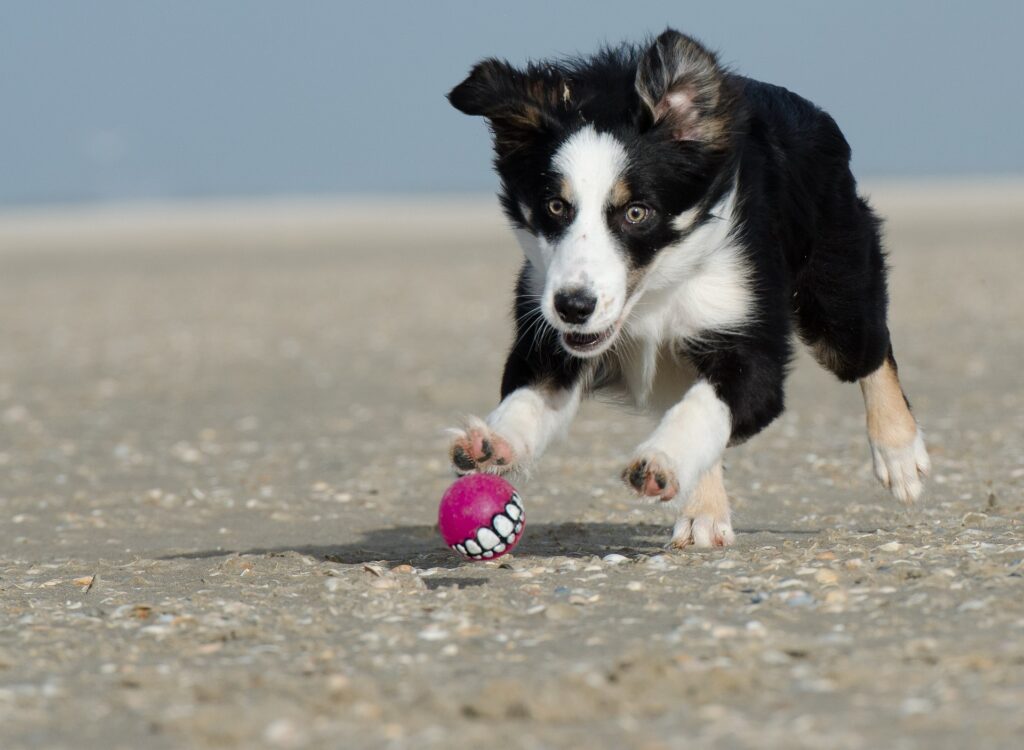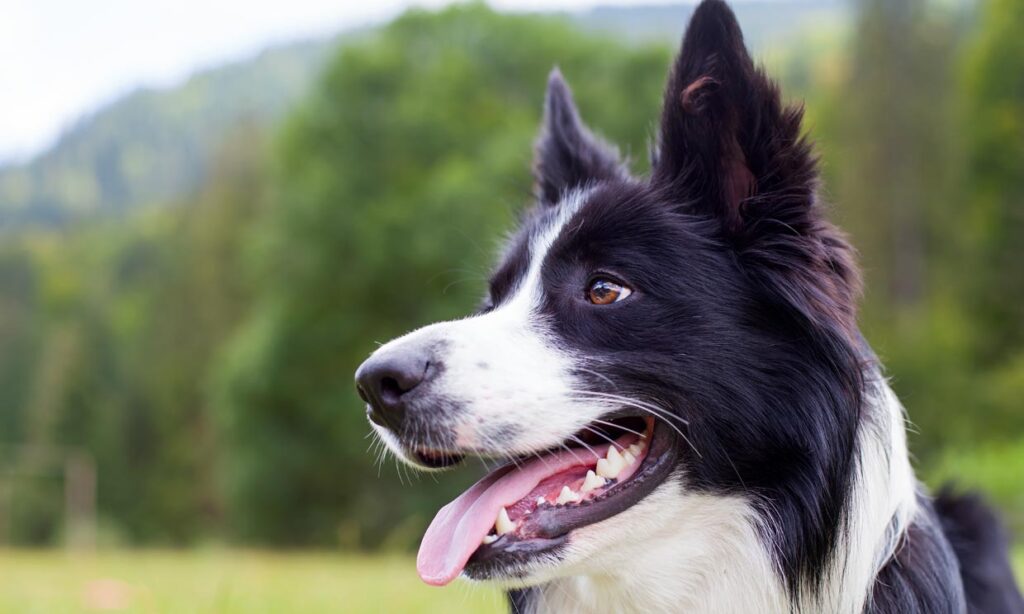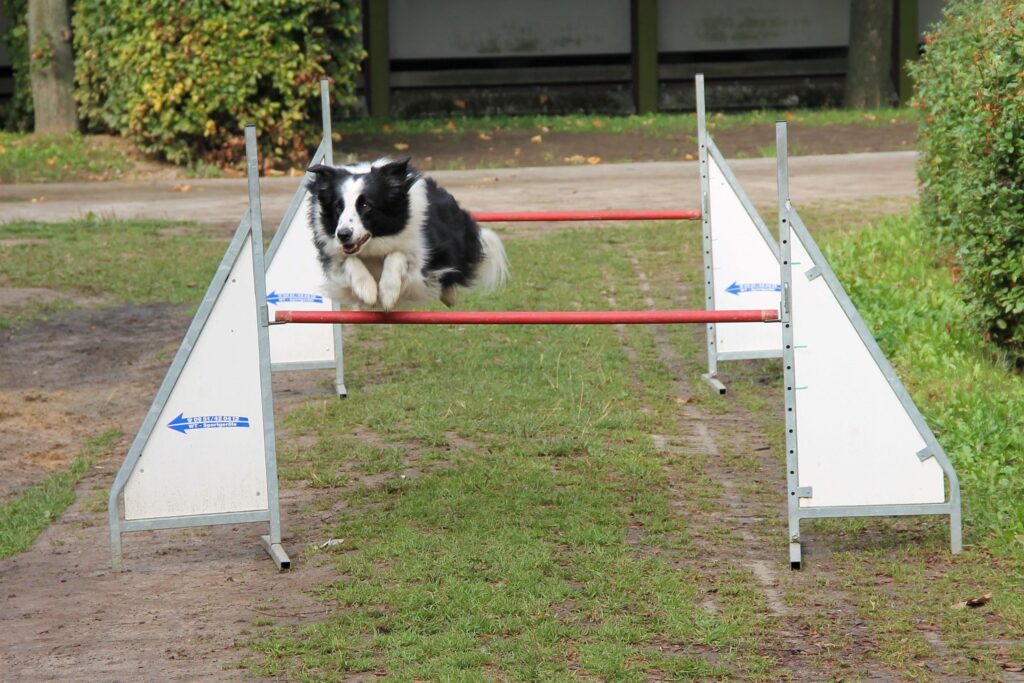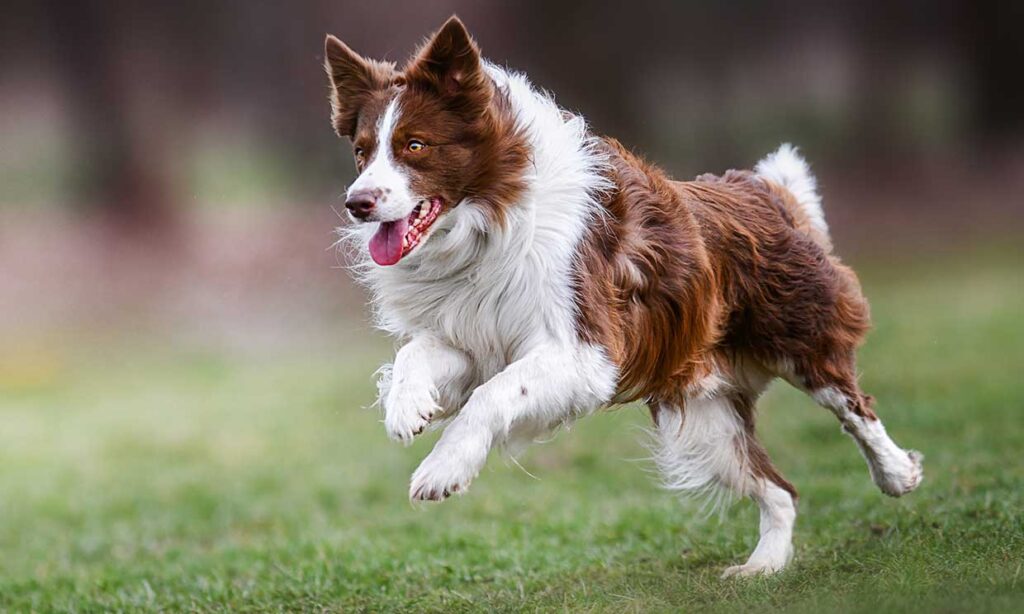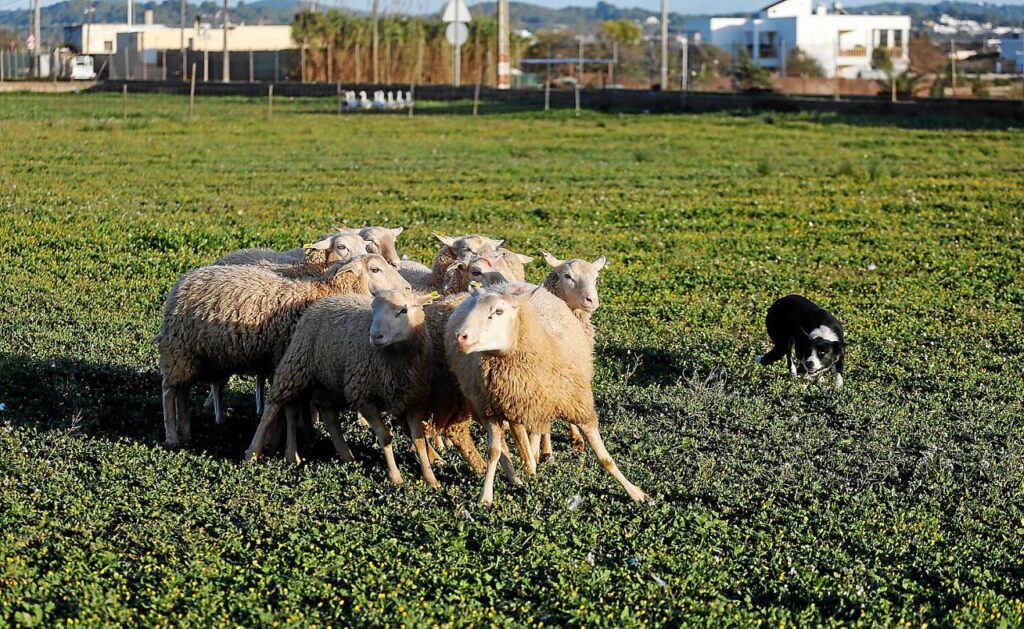The Border Collie is a dog with very unique characteristics where its intense gaze and its great capacity for obedience stand out. He is regarded as one of the most intelligent species, not to mention his faithful temperament and willingness to work. Thanks to all these qualities, with the adoption and proper training of a Border Collie Puppy, you can have a dog that will please everyone at home.
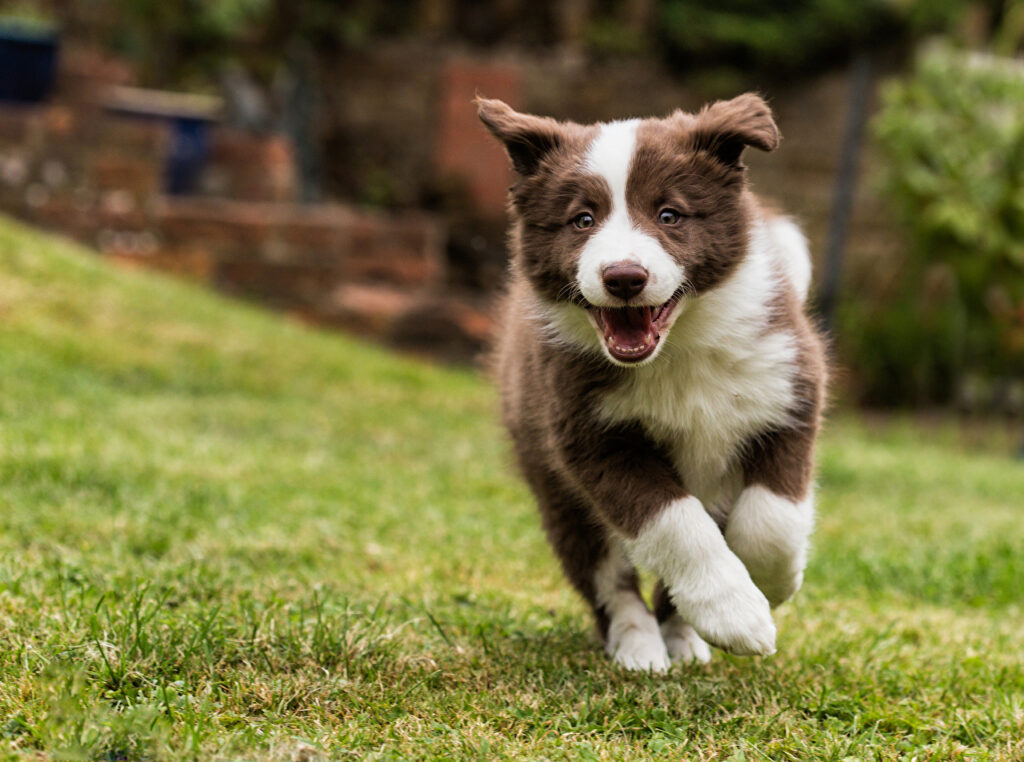
Characteristics of the Border Collie Puppy
While basic dog training patterns and principles may be shared, it is important to understand that each dog is unique. When it comes to learning, each dog will need its own time and must have the dedication and experience of its tutor to correctly assimilate and reproduce the proposed instructions. Therefore, knowing your dog is an essential step to know how to train it.
The border collie is a medium-sized animal, with a long and athletic body, strong, wide limbs and great muscularity. His physical complexion allows him to achieve high speeds when running and reach considerable heights in his jumps. These are reasons why this breed is extremely successful in sports activities and achieves optimal performance in "agility" (competitive modality in which a guide directs the animal over a variety of obstacles)
It is a genuine working dog, with a perfect disposition for herding tasks. His temperament is naturally dynamic, focused and obedient. In the field, he spends a large part of the day guarding sheep or cattle and guarding his territory. This allows you to consume a large amount of energy and maintain a balanced behavior. In home life, he requires continuous exercise to stay healthy, active and happy. Otherwise, he can manifest symptoms of stress and boredom very easily.
Appearance
In general, border collies are medium-sized dogs with a moderate, regularly thick coat that sheds frequently. They have a double layer of fur, which can sometimes be wavy. The most present colors are black and white, despite the fact that other patterns are also frequent; they wear tricolor black (black/brown/white), brown and white, and tricolor brown (brown/white/black); other colorations, such as grey, blue, red or merle, are of much lesser frequency, and usually originate from crosses with Australian Shepherds. On certain occasions, border collies exhibit a single color.
Their eye color is regularly brown or blue, and they eventually show heterochromia, particularly in merle dogs. Border collie ears can also vary, with some having fully erect, fully drooping, or semi-erect ears.
Usually, the appearance of working border collies shows greater diversity than that of show border collies, since the latter must constitute the breed standards, while in working dogs character and character are accentuated. herding skills. Whatever the case, his body is athletically shaped, low-chested, stocky, and agile. Their height varies from 50 to 60 centimeters in males and from 48 to 56 in females. The tail is relatively long, somewhat curved, heavily furred, usually with a tuft of white fur at the tip.
Character
He is extremely faithful to whoever he accepts as a leader, with whom he manages to develop an unconditional bond. Her gaze makes up one of her most outstanding features: at work time she never takes her distance from her leader, indicating an unusual capacity for concentration in other dog breeds. She is cheerful when she works, she has fun doing it. Its defined herding intuition, added to its perseverance and resistance, places it among the most sought-after breeds to congregate, control and direct flocks, being considered the best breed of shepherd dog that exists today.
Functional Intelligence and Obedience
According to the classification carried out by Stanley Coren, after examining the answers of more than two hundred working judges of the American Kennel Club AKC ("The intelligence of dogs", Stanley Coren, Editions B, 1995), to This is considered the most talented breed of dog. They attend to new commands before being repeated five times and obey the first command 95% of the time or more.
The competitive modality «agility» is a sports activity in which all those who have one or more dogs (regardless of their breed, with or without pedigree) can participate. It is that the dogs led by their guides have the ability to overcome a succession of obstacles in order to show their talent, obedience, focus, sociability and speed.
Movement
Stylized, regular and simple, slightly raising its feet, which gives the impression that it moves furtively and very quickly, leaving the impression of distinction when moving.
Hair
You can get it in three “varieties”:
- Long hair (These specimens are used regularly for canine beauty competitions or serve as companions).
- Medium hair (These are used both in "agility", as herding, in canine beauty contests... or simply for company).
- Short hair (These dogs are regularly used for herding or "agility", since they are usually animals that exhibit greater nervousness (or for company).
Food
The food we have selected for this dog must be appropriate for medium-sized breeds. If it is a puppy, choose foods enriched in calcium, protein and rice-based cereals. You can mix a dry food with one with a certain humidity, but you must do it progressively and with enough supervision before any reaction that may manifest.
When the border collie reaches adulthood (it arrives after one year), choose foods with a high protein content since this breed loves to be always moving and its energy expenditure is high. The portions of food in this phase should not be greater than 450 grams per day.
Already when entering the last phase of its life and when it begins to age, you must prevent this animal from reaching this phase of its existence with excess weight, which has depended on the food you have provided throughout its life. . In the same way, you will have to advise yourself with the veterinarian who will know the kind of food and provides it appropriately, although what is recommended is to reduce the dose somewhat, since his life does not demand as much activity as in puppy or adult times. young man.
How to Train a Border Collie Puppy?
The border collie is a dog with very special characteristics, if you have already had the opportunity to look into their eyes, you will know the unique vitality they radiate. They stand out not only for heading the list of most intelligent dogs, but also for how versatile they are, their high capacity for memorization, their charisma and vocation for work. Given sufficient stimulation, they can easily learn and perform a wide variety of sports tasks, tricks and practices perfectly.
However, we must make it clear that the border collie acts as a long-lasting rechargeable battery. If they are not taught or allowed to positively channel and externalize all this vitality, we would be favoring the development of unwanted behaviors and symptoms linked to the accumulation of tension, stress and boredom. Therefore, if you are considering adopting a dog of this breed, we invite you to learn some essential recommendations on how to train a border collie.
Preparing for Training
Training a dog as intelligent and as dynamic as a border collie requires more than good will. Before starting the education of your pet, you need to start training dogs to understand their patterns, methods and basic elements. Additionally, to facilitate your dog's learning and make the most of your time, we advise you to know the "5 tricks to train that every owner should know".
After placing yourself well in the dog training environment, it is equally important to structure your own training staff with the basic items listed below:
After placing yourself well in the dog training environment, it is equally important to structure your own training staff with the basic items listed below:
- Collar/harness.
- Regulation strap.
- Extensive strap.
- fanny pack
- Prizes or snacks.
- Toys.
- Clicker (optional).
Obviously, it should be made clear that the clicker is not considered an essential component of dog training. However, if you learn to use it properly, you will notice that it usually makes the trainer's job easier.
Training according to their age
Both the training and the physical training of any dog must be designed according to its age, health condition and physical strength. You can't start training a puppy by starting it with highly complex tasks or commands. Like children, puppies must learn step by step, starting with the fundamental concepts of obedience that will form the basis of their learning. Gradually, you will be able to increase the difficulty of the proposed tasks and, for sure, you will be amazed at the speed with which your border collie memorizes each command.
Regardless of the age at which you begin training a border collie, keep in mind the use of positive reinforcement to encourage your teaching. In contrast to what happens with the traditional system, positive education repudiates any kind of physical or emotional excess, such as punishments or reprimands. Instead of condemning bad behavior, which is harmful to the animal's mental health and education, positive reinforcement invests in the identification of appropriate behaviors to stimulate the animal's cognitive, social and emotional capacities.
Training a Border Collie Puppy
The ideal would be to start the training of the border collie from 3 months of age, when he can be separated from his mother without disrespecting his weaning period. A dog that is taken away from his parents before the appropriate time usually exhibits learning and socialization problems. If you want to stimulate the physical, emotional and cognitive skills of your border collie from its initial weeks of life, we suggest using early stimulation techniques.
In the event that the puppies were born at home, you will need to train them from birth. Although they cannot yet be taught in elementary obedience exercises, you must instruct them in the rules of your home. For example: puppies should not ride on the couch or lie on our bed. Keep in mind that if we do not promote unwanted behavior in puppies, we will not need to correct them when they are adults. It is equally important that you recognize when called by name.
Keep in mind that puppies should carry out simple activities and low intensity exercises that incorporate a high dose of entertainment. The game operates as a playful ingredient in the teaching of dogs, and it is through the game that we encourage both the curiosity and the physical and cognitive skills of our furry friends.
Training Stages
So that you know how to train your border collie puppy, in the following sections we present the most appropriate age division:
- From 3 to 6 months: We start with the teaching of the essential commands of canine submission, such as sit, come, lie down, remain still, stand up, walk by your side and not pull on the leash. What is wanted is to propose simple and unitary orders, which do not imply the execution of a multiplicity of tasks to achieve success. Exceeding the difficulty of the exercises in this phase can confuse the puppy and promote a feeling of frustration, which will affect his learning. It is also advisable to teach him to relieve himself on the street, such as not neglecting his socialization since with this he learns to relate to other dogs, animals, humans and the environment. The relevance of this point will be discussed later.
- From 6 to 12 months: Once the puppy has learned the basic commands, you can incorporate new commands. At this point, we suggest teaching him to look for objects, "speak" and "shut up". These last commands are essential since, being an excellent herding dog, the border collie can become a perennial barker. Therefore, the instructions to "speak" and "shut up" indicate the moments in which he can only bark. Additionally, you can incorporate other tricks that are to your liking, such as "roll" or "give the paw", always being considerate of the times of your canine friend.
Train from 12 months
Welcome to the extraordinary world of the thousand possibilities of a border collie! After completing the basic obedience phase, you can rejoice in your dog's intelligence and agility for advanced training to come. Taking your initiation in «agility» is a great decision to keep yourself physically and mentally motivated in your adulthood. On the other hand, searching or searching for prizes is highly recommended for the stimulation of his sensory and cognitive qualities. Added to this, they can be taught entertaining tricks, sports for dogs or games to memorize.
As it is very easy for the border collie to learn and memorize, his mind will have to be permanently stimulated, which usually turns out to be a challenge for his tutors. Therefore, we suggest you go to a training circuit to have the guidance of an expert in advanced training.
Training of an Adopted Adult
If you just adopted an adult border collie and don't know how to train him, the first thing you should do is analyze the situation. In this way, it tries to know the temperament of the animal that has just arrived home and recognizes if it shows symptoms of fear of abuse, a complex, aversion or stereotypy (temporary repetitive movements).
In case of manifesting any behavior problem, treatment should be offered before starting the education period, because if, for example, their fears are not worked on, you will not be able to make progress in their training. It is important that you can gain his trust and that he recognizes you as something positive and, particularly, safe.
Once you have the above mentioned, you can start working on your socialization and put into practice the basic commands at home. Perseverance, patience, and positive reinforcement are essential in order to properly train an adult border collie. According to the fears or traumas that the animal manifests, do not hesitate to seek the advice of a canine trainer or ethologist.
The Socialization of a Border Collie
Socialization is a fundamental component to achieve the obedience of the dog, as well as to provide it with a good education and a balanced character. Through socialization, your dog will learn to relate positively with humans, with other animals and even with their own toys. The ideal is to start the socialization of the border collie when he is still a puppy, from his 6 months of existence (this is when he completes his first vaccination and deworming period).
In the particular case of the border collie, socialization and high physical activity will be essential for the reorientation of its propensity for grazing. It is unquestionable that if we do not train the border collie puppy to graze, it may not show any instinct related to it, but it is also true that, in case of adopting an adult specimen that has been linked to that kind of activity, it can create us. problems if we don't know how to orient it correctly.
This learned behavior is so defined in this breed that, if we don't train it, our dog will end up herding other animals or children in parks and squares, which could be truly dangerous. We must teach him to live with children as members of his family and not as a member of a herd to be herded.
Now, as we pointed out, if the border collie has never been trained for grazing, nor has it been in contact with cattle or sheep, it does not have to show an inclination towards it, for example, if it is in the middle of a flock of sheep . Although research is still ongoing, it has not yet been shown that grazing is part of the instinctive behavior of certain dog breeds, so there is a greater probability that if we leave an untrained border collie among sheep, it will not You will know how to proceed and may end up, rather, with a serious injury.
Physical Activity and Mental Stimulation
As previously noted, the border collie is a true renewable energy battery. Both your body and your mind require a high dose of stimulation to stay in perfect balance. A sedentary dog or one with excessive accumulated tension will manifest inconveniences in concentrating and difficulties in learning.
Therefore, the training of the border collie should incorporate physical activity and cognitive training on a daily basis. To this end, we reiterate the concept of starting him in a dog sport and we point out some intelligence games that he could do in your own home, such as shell game or the use of food-dispensing toys.
This canine breed feels more comfortable when they live in extensive environments, where they can run freely. Raising a border collie in a small apartment or flat entails enormous difficulties, since in that way it would be practically impossible to meet his daily requirement of physical activity. They will require 3 to 4 walks each day, 40 to 60 minutes each, so that they can achieve optimal energy expenditure.
As you can see, the border collie is an animal that requires the company of a dynamic and patient guardian, with enough availability of time and space. Additionally, they must be given appropriate preventive medicine to keep them healthy, active and happy. Therefore, you must keep in mind his veterinary consultation every 6 months, follow his vaccination and deworming schedules, both internal and external, and provide him with the particular attention that this breed needs.
Training Tips
- Training demands perseverance: your border collie will require you to be committed and patient so that it can assimilate the instructions, one by one. Training is a continuous and gradual process, in which each exercise must be correctly assimilated, memorized and performed perfectly. If you don't have the time to educate your border collie, don't hesitate to find a professional trainer.
- Know when to train: Obedience drills should be taught daily, in short sections, starting at 10-15 minutes in length. By overloading the animal you favor its distraction with which you would harm its learning.
- Understand how to train: the exercises must be taught one by one to enable complete understanding and not disconcert the animal. Usually each exercise lasts from 3 to 10 days to be internalized, assimilated, memorized and fully performed. The time it takes to assimilate will depend on each dog and the difficulty of each task.
- Choosing the appropriate site: meditating on the site in which to train is as essential as knowing how and when to educate. Places where there is a lot of noise or with many stimuli, such as smells, music or too many animals, should be avoided so as not to affect our dog's concentration.
- Apply affirmative reinforcement: positive reinforcement is the best technique to encourage our dog's learning. It goes against all physical or emotional violence, as they are counterproductive and dangerous. Keep in mind to give your dog a prize for each task carried out successfully, to reward his effort and encourage his cognitive ability.
- Review the learned commands: each taught command must be reviewed so that its learning is reaffirmed and prevent it from being forgotten. We suggest setting aside 1 or 2 days each week to review the tasks already learned.
Other articles that we also recommend are:

